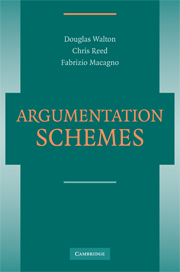Book contents
- Frontmatter
- Contents
- Acknowledgments
- Introduction
- 1 Basic Tools in the State of the Art
- 2 Schemes for Argument from Analogy, Classification, and Precedent
- 3 Knowledge-Related, Practical, and Other Schemes
- 4 Arguments from Generally Accepted Opinions, Commitment, and Character
- 5 Causal Argumentation Schemes
- 6 Schemes and Enthymemes
- 7 Attack, Rebuttal, and Refutation
- 8 The History of Schemes
- 9 A User's Compendium of Schemes
- 10 Refining the Classification of Schemes
- 11 Formalizing Schemes
- 12 Schemes in Computer Systems
- Bibliography
- Index
1 - Basic Tools in the State of the Art
Published online by Cambridge University Press: 05 June 2012
- Frontmatter
- Contents
- Acknowledgments
- Introduction
- 1 Basic Tools in the State of the Art
- 2 Schemes for Argument from Analogy, Classification, and Precedent
- 3 Knowledge-Related, Practical, and Other Schemes
- 4 Arguments from Generally Accepted Opinions, Commitment, and Character
- 5 Causal Argumentation Schemes
- 6 Schemes and Enthymemes
- 7 Attack, Rebuttal, and Refutation
- 8 The History of Schemes
- 9 A User's Compendium of Schemes
- 10 Refining the Classification of Schemes
- 11 Formalizing Schemes
- 12 Schemes in Computer Systems
- Bibliography
- Index
Summary
This chapter introduces the reader to argumentation schemes and explains, through the use of some examples, why they are important. Another aim of the chapter is to briefly review the literature on argumentation schemes, including the key works by Hastings, Walton, and Kienpointner, and to set it in a broader context, bringing out some characteristics of defeasible reasoning and argument evaluation that are fundamental to the study of schemes. Another is to introduce the beginning reader to some basic tools, like argument diagramming, that utilize schemes and need to be integrated with them. In this chapter we will introduce the reader to an automated system of argument diagramming called Araucaria. This technique is a box-and-arrow representation of the premises and conclusions of an argument, showing how one argument can be chained together with others to form a sequence of reasoning. This tool will be used in subsequent chapters, and so we need to introduce the reader to it now. One of our goals in the book is to show how argumentation schemes are in the process of being modeled by argument technology in the field of artificial intelligence (AI). However, we will reserve our fullest account of these developments for the last chapter of the book, even though, from time to time, we will mention aspects of them that impinge on our fundamental understanding of argumentation schemes as forms of reasoning.
- Type
- Chapter
- Information
- Argumentation Schemes , pp. 7 - 42Publisher: Cambridge University PressPrint publication year: 2008



